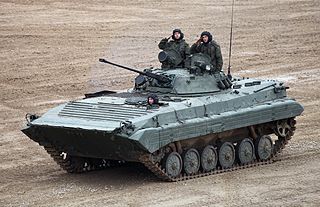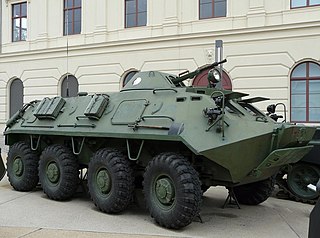
The T-62 is a Soviet main battle tank that was first introduced in 1961. As a further development of the T-55 series, the T-62 retained many similar design elements of its predecessor including low profile and thick turret armour.

The BMP-2 is an amphibious infantry fighting vehicle introduced in the 1980s in the Soviet Union, following on from the BMP-1 of the 1960s.

The Véhicule de l'Avant Blindé or VAB is a French armoured personnel carrier and support vehicle designed and manufactured by Renault Trucks Defense. It entered French service in 1979 and around 5,000 were produced for the French Army as well as for export. It has seen combat in various conflicts in Africa, Asia as well as Europe and has also been exported to more than 15 countries.

The Combat Vehicle Reconnaissance (Tracked), abbreviated CVR(T), is a family of armoured fighting vehicles (AFVs) developed in the 1960s and is in service with the British Army and others throughout the world. They are small, highly mobile, air-transportable armoured vehicles, originally designed to replace the Alvis Saladin armoured car.

The FV101 Scorpion is a British armoured reconnaissance vehicle and light tank. It was the lead vehicle and the fire support type in the Combat Vehicle Reconnaissance (Tracked), CVR(T), family of seven armoured vehicles. Manufactured by Alvis, it was introduced into service with the British Army in 1973 and was withdrawn in 1994. More than 3,000 were produced and used as a reconnaissance vehicle or a light tank.

The BRDM-2 is an amphibious armoured scout car designed and developed in the Soviet Union. It was also known under the designations BTR-40PB, BTR-40P-2 and GAZ 41-08. This vehicle, like many other Soviet designs, has been exported extensively and is in use in at least 38 countries. It was intended to replace the older BRDM-1, and has improved amphibious capabilities and better armament compared to its predecessor. The BRDM-2 production continues in Poland as of 2022.

The Warrior tracked vehicle family is a series of British armoured vehicles, originally developed to replace FV430 series armoured vehicles. The Warrior started life as the MCV-80, "Mechanised Combat Vehicle for the 1980s". One of the requirements of the new vehicle was a top speed able to keep up with the projected new MBT, the MBT-80 – later cancelled and replaced by what became the Challenger 1 – which the FV432 armoured personnel carrier could not. The project was begun in 1972; GKN Defence won the production contract in 1984 and the Warrior was accepted for service with the British Army in November 1984. Production commenced in January 1986 at Telford, with the first vehicles completed in December that year. GKN Defence was purchased by BAE Systems, via Alvis plc.

The BTR-60 is the first vehicle in a series of Soviet eight-wheeled armoured personnel carriers (APCs). It was developed in the late 1950s as a replacement for the BTR-152 and was seen in public for the first time in 1961. BTR stands for bronetransportyor.

The FV432 is the armoured personnel carrier variant in the British Army's FV430 series of armoured fighting vehicles. Since its introduction in the 1960s, it has been the most common variant, being used for transporting infantry on the battlefield. At its peak in the 1980s, almost 2,500 vehicles were in use.

The Ferret armoured car, also commonly called the Ferret scout car, is a British armoured fighting vehicle designed and built for reconnaissance purposes. The Ferret was produced between 1952 and 1971 by the UK company Daimler. It was widely used by regiments in the British Army, as well as the RAF Regiment and Commonwealth countries throughout the period.

The AMX-10 RC is a French armoured fighting vehicle manufactured by Nexter Systems for armoured reconnaissance purposes. Equipping French cavalry units since 1981, over 240 remained in service with the French Army in 2021. 108 units were sold to Morocco and 12 to Qatar. "RC" stands for "Roues-Canon", meaning "wheeled gun". English language newspapers have often incorrectly referred to it as a light tank, a mistranslation of the French term "char", which refers to a wider category of armored fighting vehicles than the English word "tank".

The AMX-10P is a French amphibious infantry fighting vehicle. It was developed from 1965 onwards to replace the AMX-VCI in the French Army. It served with the French Army from its introduction in 1973 until its retirement in 2015, when it was fully replaced by the VBCI.

The FV721 Fox Combat Vehicle Reconnaissance (Wheeled) (CVR(W)) was a 4 × 4 armoured car manufactured by ROF Leeds, deployed by the British Army as a replacement for the Ferret scout car and the Saladin armoured car. The Fox was introduced into service with B Squadron, 1st Royal Tank Regiment (Aliwal Barracks, Tidworth) in 1975 and withdrawn from service 1993–94.

The Austin Armoured Car was a British armoured car produced during the First World War. The vehicle is best known for its employment by the Imperial Russian Army in the First World War and by different forces in the Russian Civil War.
A huge number of M113 Armored Personnel Carrier variants have been created, ranging from infantry carriers to nuclear missile carriers. The M113 armored personnel carrier has become one of the most prolific armored vehicles of the second half of the 20th century, and continues to serve with armies around the world in many roles.

The Simba is a wheeled armoured personnel carrier designed by GKN Sankey. and is currently in service with the Philippine Army.

During the First World War, sixteen American Peerless trucks were modified by the British to serve as armoured cars. These were relatively primitive designs with open backs, armed with a Pom-pom gun and a machine gun, and were delivered to the British Army in 1915. They were used also by the Imperial Russian Army as self-propelled anti-aircraft guns.

The OT-62 TOPAS is a series of amphibious tracked armoured personnel carriers developed jointly by Polish People's Republic and Czechoslovakia (ČSSR). OT-62 stands for Obrněný Transportér vzor 62 – "armoured personnel carrier model 62". TOPAS stands for Transportér Obrněný Pásový – "tracked armoured personnel carrier".

The Type 85 is a tracked armoured fighting vehicle produced by Chinese company Norinco. It is an improved version of the Type 63 armoured personnel carrier. The vehicle is bigger, has additional firing ports and periscopes, a longer chassis with an additional road wheel on each side, and is equipped with an NBC protection system.

The Panther KF51 is a German main battle tank (MBT) that is under development by Rheinmetall Landsysteme. It was unveiled publicly at the Eurosatory defence exhibition on 13 June 2022.






















